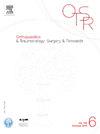显微手术与血管痉挛:收割时的痉挛预测因素。
IF 2.3
3区 医学
Q2 ORTHOPEDICS
引用次数: 0
摘要
背景:显微外科手术中的血管痉挛(VS)是手术并发症、重复手术、患者和手术团队压力以及住院时间延长的根源。目前已经发现了各种风险因素,但对相关机制的了解仍然有限:我们的目标是确定显微外科脚趾移植的采集条件是否会增加 VS 的风险。我们的次要目标是确定皮瓣分割前发生 VS 与完成血管吻合后发生血管并发症之间的相关性:主要终点是是否存在下肢局部麻醉、吉尔伯特分类、取自足部的移植物性质、患者特征和吸烟状况。我们的次要终点是出现继发性 VS 或显微手术失败。该系列包括 14 例足趾移植,历时 30 个月。原发性 VS 被定义为发生在皮瓣分割之前,而继发性 VS 则发生在转移之后:在这个系列中,我们发现了 4 例原发性 VS。手术患者的平均年龄为 30.6±11.2 岁(16-58 岁)。原发性 VS 患者的平均年龄为(35.3±16.2)岁(21-58)岁,与另一组患者无统计学差异(P = 0.54)。在脚趾转移过程中,未进行局部麻醉与原发性 VS 发生率之间存在统计学差异(p = 0.0008)。有 1 例显微手术失败。这次失败与原发性 VS 的存在有关。吉尔伯特分类和移植物类型并不能预测 VS 的发生(p = 0.15 和 p = 0.08)。继发性 VS 的发生与原发性 VS 的发生有统计学联系(p = 0.009):讨论:VS 的发生仍然难以预测,文献中对现有治疗方法的有效性也存在争议。面对治疗的失败,本研究旨在确定 VS 的预测因素。继发性 VS 如果持续时间长且对常规措施无反应,则可能导致吻合口翻修。对下肢进行局部麻醉可有效防止 VS 的发生。无原发性 VS 与无继发性 VS 和无显微手术失败相关。除了控制血管痉挛外,区域麻醉还能有效镇痛摘取部位:证据等级:IV。本文章由计算机程序翻译,如有差异,请以英文原文为准。
Microsurgery and vasospasms: Spasms’ predictive factors during harvesting
Background
Vasospasm (VS) in microsurgery is a source of surgical complications, repeat operations, stress for the patient and the surgical team, as well as increased length of stay. Various risk factors have been identified but knowledge regarding the implicated mechanism remains limited.
Hypothesis
Our objective was to determine if the harvesting conditions for microsurgical toe transfers could increase the risk of VS. Our secondary objective was to determine the correlation between VS occurrence before flap division, and the occurrence of vascular complications after completion of vascular anastomoses.
Patients and methods
Primary endpoints were the existence of locoregional anaesthesia of the lower limb, the Gilbert classification, the nature of the graft taken from the foot, the characteristics of the patients and smoking status. Our secondary endpoints were the presence of secondary VS or microsurgical failure. This series consists of 14 toe transfers over a 30-month period. Primary VS was defined as occurring prior to flap division, while secondary VS occurred after transfer.
Results
In this series, we identified 4 cases of primary VS. The average age of the operated population was 30.6 ± 11.2 years (16–58). The patients who presented with primary VS had a mean age of 35.3 ± 16.2 years (21−58), with no statistical difference with the other group (p = 0.54). There was a statistically significant difference between the absence of locoregional anaesthesia and the occurrence of primary VS in toe transfer (p = 0.0008). Microsurgical failure occurred in 1 case. This failure was linked to the presence of a primary VS. Gilbert's classification and type of graft were not predictive of VS (p = 0.15 and p = 0.08, respectively). The occurrence of secondary VS was statistically linked to the occurrence of primary VS (p = 0.009).
Discussion
The occurrence of VS remains unpredictable and the effectiveness of available treatments is debated in the literature. Faced with the failure of curative treatments, this study aimed to determine predictive factors for VS. The existence of secondary VS, when prolonged and non-responsive to conventional measures, can lead to anastomotic revision. Performing locoregional anaesthesia on the lower limb makes it possible to effectively combat the occurrence of VS. The absence of primary VS was correlated with an absence of secondary VS and an absence of microsurgical failure. In addition to controlling vasospasm, regional anaesthesia provides effective analgesia at the harvesting site.
Level of evidence
IV
求助全文
通过发布文献求助,成功后即可免费获取论文全文。
去求助
来源期刊
CiteScore
5.10
自引率
26.10%
发文量
329
审稿时长
12.5 weeks
期刊介绍:
Orthopaedics & Traumatology: Surgery & Research (OTSR) publishes original scientific work in English related to all domains of orthopaedics. Original articles, Reviews, Technical notes and Concise follow-up of a former OTSR study are published in English in electronic form only and indexed in the main international databases.

 求助内容:
求助内容: 应助结果提醒方式:
应助结果提醒方式:


